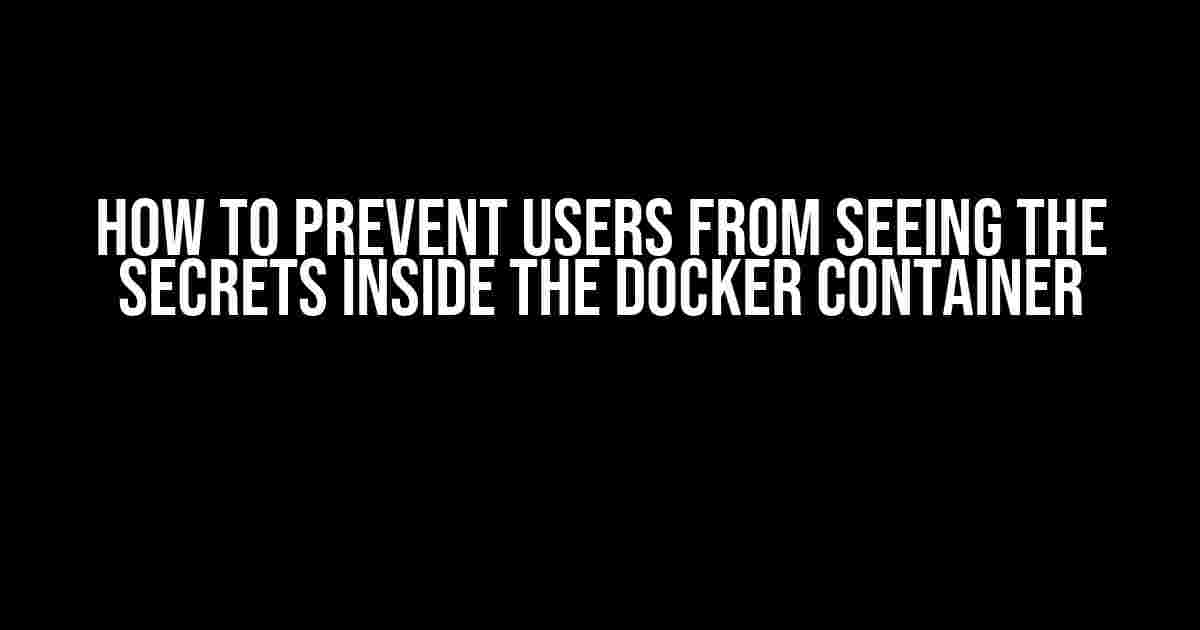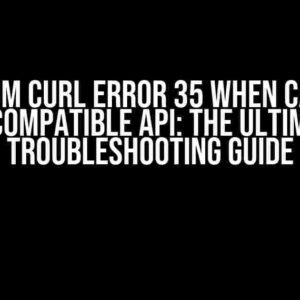As a Docker enthusiast, you’re probably aware of the importance of keeping sensitive information, such as API keys, passwords, and encryption keys, out of prying eyes. After all, who wants their secrets exposed to the world? In this article, we’ll delve into the world of Docker security and explore ways to prevent users from snooping around inside your Docker containers.
Understanding the Risks
Before we dive into the solutions, let’s talk about the potential risks. When you create a Docker container, it’s essentially a self-contained environment that runs your application. However, this environment can be accessed by anyone with docker exec privileges, which means they can potentially view sensitive information stored inside the container.
docker exec -it my-container bash
This command allows you to access the container’s bash shell, where you can explore the file system, environment variables, and even modify the container’s settings. But what if you don’t want users to have this level of access?
Method 1: Use Environment Variables with Care
One common method of storing secrets is by using environment variables. While convenient, this approach has its drawbacks. Anyone with access to the container can view the environment variables using the following command:
docker exec -it my-container printenv
To mitigate this risk, consider the following best practices:
- Use a secrets management tool, such as Docker Secrets or HashiCorp’s Vault, to store and manage sensitive information.
- Only set environment variables that are absolutely necessary for the application to function.
- Use a secure method to inject environment variables, such as using Docker Compose’s
env_filedirective.
Method 2: Utilize Docker Volumes
Docker Volumes provide a way to persist data even after a container is deleted. However, this persistence comes with a risk: anyone with access to the host machine can view the volume’s contents.
| Volumes vs. Bind Mounts | Volumes | Bind Mounts |
|---|---|---|
| Persistence | Yes | No |
| Security | Risk of exposure on host machine | Risk of exposure within container |
To minimize this risk, consider the following:
- Use a secure storage solution, such as an encrypted file system or a secure object store.
- Limit access to the host machine and ensure only trusted users have access to the volumes.
Method 3: Leverage Docker’s Built-in Security Features
Docker provides several built-in security features to help you protect your containers. Let’s explore a few:
User Namespace
By default, Docker containers run as the root user. To reduce the attack surface, consider using a non-root user namespace:
docker run -u 1001 my-image
This command runs the container as user 1001, limiting the potential damage in case of a breach.
Capabilities
Docker provides a mechanism to restrict the capabilities of a container. This can help prevent privilege escalation attacks. For example, you can drop the NET_BIND_SERVICE capability to prevent the container from binding to privileged ports:
docker run --cap-drop NET_BIND_SERVICE my-image
By dropping this capability, you’re limiting the container’s ability to bind to ports below 1024.
Method 4: Implement Access Control Lists (ACLs)
ACLs provide a way to restrict access to the container’s file system and resources. By setting up ACLs, you can control who has read, write, or execute permissions on specific files and directories.
docker run --acl publish,read:/var/my-app my-image
This command sets up an ACL that allows the container to read from the /var/my-app directory, but prevents writing or executing files within that directory.
Putting it All Together
By combining these methods, you can create a robust security framework for your Docker containers. Here’s an example of how you might implement these strategies:
docker run \ -u 1001 \ --cap-drop NET_BIND_SERVICE \ --acl publish,read:/var/my-app \ -e MY_SECRET_KEY=$(docker secret my-secret) \ -v my-secure-volume:/var/my-app \ my-image
In this example, we’re:
- Running the container as user 1001.
- Dropping the
NET_BIND_SERVICEcapability. - Setting up an ACL to restrict access to the
/var/my-appdirectory. - Using a Docker secret to inject the
MY_SECRET_KEYenvironment variable. - Mounting a secure volume to persist data.
By following these best practices, you can significantly reduce the risk of users accessing sensitive information within your Docker containers.
Conclusion
In conclusion, preventing users from seeing the secrets inside a Docker container requires a multi-faceted approach. By understanding the risks, using environment variables with care, utilizing Docker volumes, leveraging Docker’s built-in security features, and implementing access control lists, you can create a robust security framework for your Docker containers.
Remember, security is an ongoing process, and it’s essential to stay up-to-date with the latest Docker security best practices to ensure the integrity of your applications.
Stay secure, and happy Docker-ing!
Frequently Asked Question
Are you concerned about keeping your Docker container’s secrets, well, secret? Don’t worry, we’ve got you covered! Here are some frequently asked questions about preventing users from seeing the secrets inside your Docker container:
Q1: How do I prevent users from accessing the Docker container’s file system?
Use the `–security-opt` flag when running your Docker container to restrict access to the file system. For example, `docker run –security-opt=no-new-privileges –security-opt.apparmor=docker-default my-image`. This will prevent users from accessing the file system and modifying sensitive data.
Q2: Can I use environment variables to store sensitive data?
While environment variables can be used to store sensitive data, they’re not the most secure option. Environment variables can be accessed by users with access to the container, and they’re also stored in plain text in the Docker container’s configuration file. Instead, consider using a secrets management tool like Docker Secrets or HashiCorp’s Vault.
Q3: What’s the best way to handle sensitive data in a Dockerfile?
When handling sensitive data in a Dockerfile, use the `ARG` instruction instead of `ENV`. `ARG` values are only available during the build process and are not stored in the final image, whereas `ENV` values are stored in the image and can be accessed by users.
Q4: How do I prevent users from executing commands inside the Docker container?
Use the `–no-new-privileges` flag when running your Docker container to prevent users from executing commands inside the container. You can also use the `USER` instruction in your Dockerfile to specify a non-root user to run the container as, limiting the user’s privileges.
Q5: Are there any third-party tools that can help me secure my Docker container?
Yes! There are many third-party tools available that can help you secure your Docker container, such as Docker Bench, Clair, and Anchore. These tools can help you identify vulnerabilities, monitor your container’s activity, and enforce security policies.



